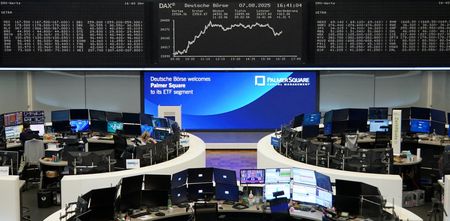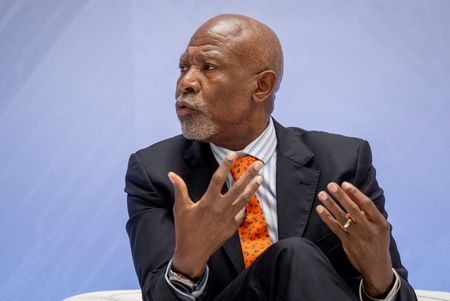By Arathy Somasekhar
HOUSTON (Reuters) -Oil held steady on Friday as markets awaited a meeting in coming days between Russian president Vladimir Putin and his U.S. counterpart Donald Trump, but prices marked their steepest weekly losses since late June on a tariff-hit economic outlook.
Brent crude futures settled 16 cents, or 0.2%, higher at $66.59 a barrel, while U.S. West Texas Intermediate crude futures were unchanged at $63.88.
Brent fell 4.4% over the week, while WTI finished 5.1% lower than last Friday’s close.
U.S. crude fell over 1% earlier in the session after Bloomberg News reported that Washington and Moscow were aiming to reach a deal to halt the war in Ukraine that would lock in Russia’s occupation of territory seized during its military invasion.
U.S. and Russian officials are working towards an agreement on territories for a planned summit meeting between Trump and Putin as early as next week, the report said, citing people familiar with the matter.
The potential meeting raises expectations of a diplomatic end to the war in Ukraine, which could lead to eased sanctions on Russia, and comes as trade tensions have been on the rise between Trump and buyers of Russian oil.
This week, Trump threatened to increase tariffs on India if it kept purchasing Russian oil. Trump also said China, the largest buyer of Russian crude, could be hit with tariffs similar to those levied against Indian imports.
“Various non-oil considerations are at play, including fears over the impact of tariffs and the headlines flying over the last few days regarding a Trump and Putin meeting in the near term,” said Neil Crosby, an energy market analyst at Sparta Commodities.
“Headline risk is particularly strong currently with flip-flopping regarding who will turn up to a meeting over Ukraine and under what circumstances.”
Higher U.S. tariffs on imports from a host of trade partners went into effect on Thursday, raising concern over economic activity and demand for crude oil, ANZ Bank analysts said in a note.
OPEC+ agreed on Sunday to raise oil production by 547,000 barrels per day for September, the latest in a series of accelerated output hikes to regain market share, adding to supply.
The U.S. oil rig count, an indicator of future supply, rose by one to 411 this week.
“Bearish sentiment has returned this week as key OPEC+ members announced a second ‘quadruple’ output unwind for September (thus fully restoring their extra voluntary cuts of 2.2 mmb/d) and President Trump’s sweeping import tariffs took effect against most countries,” analysts at FGE NexantECA said.
Trump on Thursday also said he will nominate Council of Economic Advisers Chairman Stephen Miran to serve out the final few months of a newly vacant seat at the Federal Reserve, fuelling expectations of a more dovish policy ahead.
Lower interest rates reduce consumer borrowing costs and can boost economic growth and demand for oil.
The dollar firmed on Friday but headed for a weekly fall. A stronger dollar hurts demand for dollar-denominated crude from foreign buyers.
Money managers cut their net long U.S. crude futures and options positions in the week to August 5, the U.S. Commodity Futures Trading Commission (CFTC) said.
(Additional reporting by Colleen Howe in Beijing and Ahmad Ghaddar in London; Editing by David Goodman, Marguerita Choy and Nia Williams)








